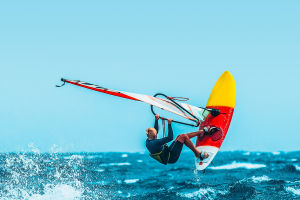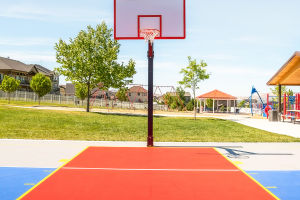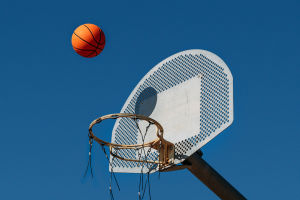
Windsurfing, also known as windsurf board or sailboarding, is an exciting water sport that combines aspects of sailing and surfing. The sport involves using a windsurfing board propelled by a sail, typically between 2 to 5 meters in length.
The sail area generally ranges from 3 to 12 square meters, supported by a mast and a boom. The windsurfer controls the direction of the board by tilting the sail, which can change the angle in relation to the wind.
Tilting the sail towards the rear of the board directs it towards the wind, while tilting it towards the mast moves the board away from the wind. The sails are usually made from polyester fabric or sometimes even a more durable fabric.
This thrilling sport is a fusion of elements from sailing and water skiing, with hints of skateboarding, snowboarding, and other similar sports. Windsurfing is a prominent competition in large events such as the Summer Olympics and the Asian Games.
Types of Windsurfing Boards
There are different types of windsurfing boards designed for various levels and conditions. Here’s a breakdown:
1. Beginner Boards
For beginners, these boards offer great stability with high buoyancy, making them ideal for first-time windsurfers. They’re also equipped with a fixed fin and are suitable for light to moderate winds.
Buoyancy: 170–250L
Length: 250–300 cm
Board Width: 75–95 cm
2. Junior Boards
These boards are specially designed for children or smaller, less experienced users. With a foam-covered surface for extra protection, these boards are made for beginners, ensuring safety and ease of learning.
Buoyancy: 70–120L
Length: 230–245 cm
Board Width: 55–72 cm
3. Freeride Boards
Freeride boards are slightly more advanced, designed for windsurfers who have already grasped the basics and are looking to improve their skills. These boards offer good maneuverability, allowing the rider to glide more easily and start planning with less wind.
Buoyancy: 125–175L
Length: 255–275 cm
Board Width: 70–85 cm
4. Freemove Boards
These are a smaller version of the freeride boards, offering excellent maneuverability without sacrificing speed. They are perfect for experienced riders looking for a balance of speed and control.
Buoyancy: 85–120L
Length: 235–250 cm
Board Width: 56–70 cm
5. Freestyle Boards
Freestyle boards are perfect for those who enjoy jumping and performing tricks. The short design of these boards makes it easier to get air and planing early. It’s ideal for learning new tricks and refining your windsurfing skills.
Buoyancy: 90–120L
Length: 230–245 cm
Board Width: 56–70 cm
6. Freestyle Wave Boards
These boards are specifically designed for moderate winds with small waves. They are narrower than freestyle boards but still offer excellent turning capabilities. Freestyle wave boards are perfect for performing quick turns and planing in various conditions.
Buoyancy: 75–100L
Length: 235–250 cm
Board Width: 55–62 cm
7. Wave Boards
Wave boards are built to withstand strong winds and large waves, making them perfect for windsurfing in challenging environments. They are also designed to handle hard turns and higher jumps, providing stability and durability.
Buoyancy: 60–90L
Length: 220–250 cm
Board Width: 53–62 cm
8. Race-Slalom Boards
These boards are designed for high-speed races and competitions. They are typically harder to control but offer exceptional speed, making them suitable for advanced windsurfers who are looking to compete.
Buoyancy: 90–135L
Length: 235–255 cm
Board Width: 60–80 cm
9. Speed Boards
Speed boards are extremely narrow and short, designed for maximum speed. They are typically used by advanced riders who are interested in racing or breaking speed records on the water.
Buoyancy: 60–70L
Length: 230–240 cm
Board Width: 50 cm
10. Formula Race Boards
Formula race boards are specialized for high-tech racing events. These boards are much wider and can support sails up to 12.5 square meters, designed for experienced windsurfers aiming for high-performance competitions.
Buoyancy: 150–180L
Length: 235–250 cm
Board Width: 100 cm
11. Longboards
Longboards are back in the market due to new manufacturing technology. They are suitable for all wind conditions, from light breezes to strong winds, and can be used in calm waters or in waves.
Buoyancy: 180–250L
Length: 300–380 cm
Board Width: 60–80 cm
12. Mistral Boards
Mistral boards were the official boards for the Olympic windsurfing events in 1996, 2000, and 2004. They are ideal for use in ging from 5 to 35 knots.
Buoyancy: 235L
Length: 372 cm
Board Width: 63 cm
Sail Area: 7.4 m²
13. RS:X Boards
The RS:X boards were the official boards for the windsurfing competition at the 2008 Summer Olympics. They come with specific sail sizes for both men and women, ensuring that competitors can race at optimal speeds.
Buoyancy: 231L
Length: 286 cm
Board Width: 93 cm
Sail Area: Men’s: 9.5 m², Women’s: 8.5 m²
Windsurfing is not just a sport; it's an experience that blends nature, excitement, and athleticism. Whether you’re a beginner or an experienced windsurfer, choosing the right board for your skill level and conditions is key to enjoying this thrilling sport. Have fun, and remember to always check the wind conditions before you hit the water!
First Time Windsurfing Skills (Self Rescue, Steering, Tack, Falling, Return to Dock)
Video by Will Spargur


